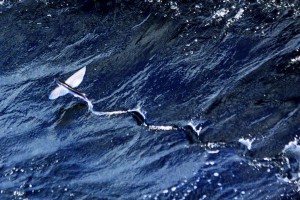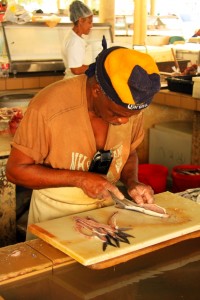Ever since we left Barbados, we have been watching flying fish jump out of the way of our bow wake. A bow wake is the wave that the ship makes in front of it as it pushes water out of the way. Flying fish are small, about five to fourteen inches, give or take a few inches. They are blue and silvery. And they do really fly over the waves! They do this to avoid being eaten by predators. When they sense our ship approaching, they think that a larger hungry creature is honing in for a snack. They have evolved large pectoral fins (the fins on either side of a fish, near the head and gills) that serve as wings. They leap out of the water, and glide over the sea surface in the air, fleeing from a would-be killer. It is not easy to stay alive as a fish or a plankter (singular of plankton) living in the ocean. Your predators can come from any direction, left, right, up and down. In the open ocean, there is usually no place to hide. For this reason, animals have evolved with specialized methods for avoiding being the next meal. Flying fish are a perfect example of a special adaptation – a fish that can fly! Other examples of adaptations for survival are camouflage, and schooling behavior.
Flying fish are not just cool; they are also tasty! They are the national dish of Barbados, where you can find many a vendor selling flying fish sandwiches.
Here is a poem I wrote about flying fish:
Flying fish, what a delectable dish,
but also pretty cool flying in a school.
These little guys really do fly,
bouncing from trough to crest.
When the bow wave bulges from ship or shark,
the flying fish heads away from the dark.
Out of the blue and into the sky,
away from sharp jaws glittering fish fly.
Most fish jump, then hop and then,
Plop! Back into the water and
met with inevitable slaughter.
Not the flying fish, no!
Up and away they go.
shooting toward the sun.
Away from danger into a world
all the more stranger.
An ironic twist for our favorite fish:
they cannot breathe air as one might wish,
if one were hurdling over the waves.
And instead of gliding to safety,
may end up on deck as a dinner quite tasty.
- Karen Stamieszkin



Love that poem! Ha Ha and Yum Yum!
Do you think that researching flying every day is fun? Do you see the same fish every day or do you see all different kinds of fish? Are some small or are some big? What are the names of the fish? What color are they? What made you choose to research flying fish… did you know there was such thing as a flying fish or did you just request the job and wanted to learn about new things and animals?!!!!!!!!!
Dear Kayla, I think that researching flying would be really fun. However, the flying fish were just a bonus for me – I don’t actually study them! One of the exciting things about going to sea is that you learn about all sorts of things that you didn’t even plan to (flying fish, for example). You can learn a lot about an animal just from watching it, and at sea, you get to watch things that you’ve never seen before. Just the other day we saw some whales. Based on the shape of the flukes and the shape of their blows, I think they were sperm whales. I have never seen them before!
Back to the fish. In our plankton net tows, we see lots of different fish! Some are larger and some are smaller, but they are all small enough to get caught in a slow-moving plankton net. We also saw a mahi-mahi, or “dolphin” fish. This fish is called a dolphin, but has nothing to do with the mammal dolphins. This fish was about three feet long, and was brilliantly colored. People also sometimes call these fish “dorado”, which means gold in spanish, because they are brilliant yellow, green and turquoise.
Love the poem. Karen you are so clever